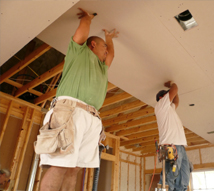You don’t need to hire a specialist for repairing damaged drywall. Here are ways to fix common problems with drywall, as well as the utilities needed.
drywall. Here are ways to fix common problems with drywall, as well as the utilities needed.
Required Tools and Materials
Joint tape
Primer
Premixed joint compound
Spackle knife
Utility knife
Metal bread pan
Drywall clips
Putty knife
Drywall saw
Hammer
Long nose pliers
1 1/4-inch (3-cm) Type W drywall screws
Caulk
Sandpaper
Electric drill
How to Fill Tiny Holes
Put some caulk on your finger and put it on the hole. Don’t leave any remains on the surrounding area. If shrinkage occurs, apply another coating. Touch it up with paint after drying.
Fixing a Small Hole
Put some premixed joint compound on the steel bread pan. To make repairing damaged drywall easier, lift a bit of the compound with the spackle knife. Apply this on the gouge. Don’t set the knife at a high angle; draw the mixture in a horizontal manner. Next, wipe the knife’s edge on the metal pan. Make a second pass, this time done vertically.
Allow the coat to dry. You’ll know it’s dry because it will turn white from gray. Apply a second layer. The second layer should be larger than the first one. It should extend farther than the first coat. If it’s not enough, add a third layer. Sand the patch when it’s dry. Add some primer over this area. Paint it.
How to Fix Popped Fasteners
To start repairing damaged drywall, insert a drywall screw on both sides of the fastener. Make sure you are pressing firmly on it. You can use a screwdriver or drill for this task. Now the fastener needs to be driven it tightly. Use a hammer or screwdriver.
Take off the loose drywall. Make sure you don’t rip off any paper facing. Put joint compound on it. Smoothen it out as you did when fixing small holes.
How to Fix Large Damaged Areas
Put joint tape on the paper facing that is damaged. Put a bit of joint compound on it. Now press the paper on the compound. Use the spackle knife to smoothen it. There should be pressure on the knife as you apply it.
To continue repairing damaged drywall, allow the first coat to dry. Before adding a second layer, scrape the bits off the surface first. Add a third layer if needed.
Fixing a Big Hole
Begin by cutting a drywall patch. Place it on the damaged section. Trace it and cut with the drywall saw. Take out the damaged parts. Get your utility knife and clean the spot. Put drywall clips on the four opening corners.
Slip it over the drywall. Fasten them with the 1 1/4-inch (3-cm) type W drywall screws. Grab the clip tabs using the pliers. Tape it and use the knife to smoothen the area; the process is similar to fixing large damaged areas.
Repairing damaged drywall is not that hard as long as you have the right tools and know the right procedures. By simply following the procedures, patching up those holes won’t be a problem.


